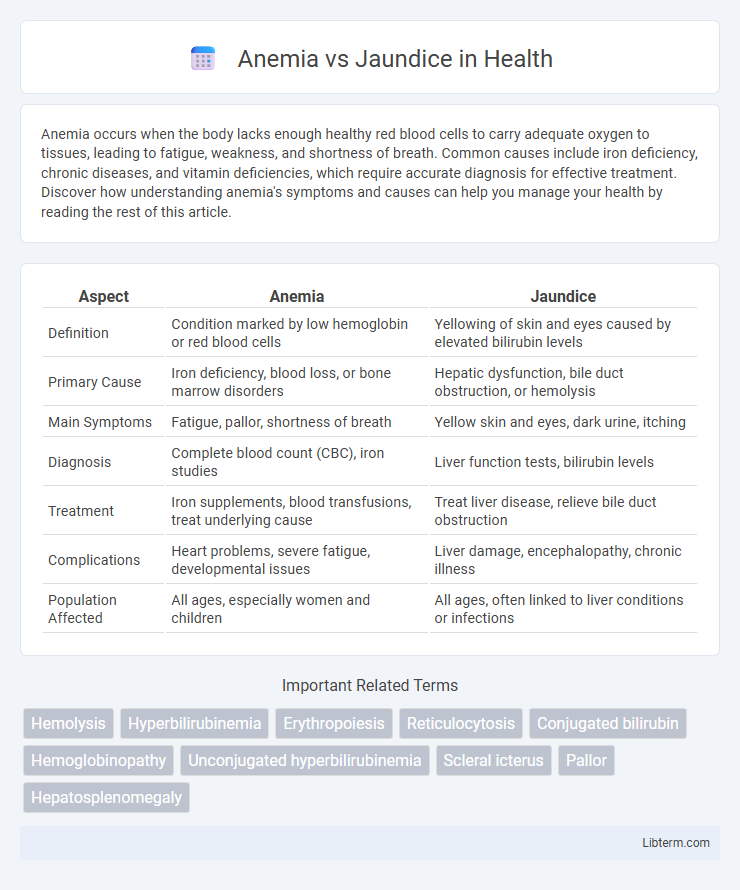Anemia occurs when the body lacks enough healthy red blood cells to carry adequate oxygen to tissues, leading to fatigue, weakness, and shortness of breath. Common causes include iron deficiency, chronic diseases, and vitamin deficiencies, which require accurate diagnosis for effective treatment. Discover how understanding anemia's symptoms and causes can help you manage your health by reading the rest of this article.
Table of Comparison
| Aspect | Anemia | Jaundice |
|---|---|---|
| Definition | Condition marked by low hemoglobin or red blood cells | Yellowing of skin and eyes caused by elevated bilirubin levels |
| Primary Cause | Iron deficiency, blood loss, or bone marrow disorders | Hepatic dysfunction, bile duct obstruction, or hemolysis |
| Main Symptoms | Fatigue, pallor, shortness of breath | Yellow skin and eyes, dark urine, itching |
| Diagnosis | Complete blood count (CBC), iron studies | Liver function tests, bilirubin levels |
| Treatment | Iron supplements, blood transfusions, treat underlying cause | Treat liver disease, relieve bile duct obstruction |
| Complications | Heart problems, severe fatigue, developmental issues | Liver damage, encephalopathy, chronic illness |
| Population Affected | All ages, especially women and children | All ages, often linked to liver conditions or infections |
Understanding Anemia: Definition and Causes
Anemia is a medical condition characterized by a deficiency in the number or quality of red blood cells, leading to decreased oxygen transport in the body. Common causes include iron deficiency, chronic diseases, vitamin B12 or folate deficiency, and genetic disorders like sickle cell anemia. Understanding these causes is crucial for effective diagnosis and treatment, differentiating anemia from jaundice, which primarily involves bilirubin metabolism and liver function abnormalities.
What is Jaundice? Key Facts and Origins
Jaundice is a medical condition characterized by yellowing of the skin and eyes caused by elevated bilirubin levels in the blood, often indicating liver dysfunction or bile duct obstruction. It originates from hemolysis, liver diseases like hepatitis or cirrhosis, or gallstones that impair bilirubin metabolism or excretion. Key facts include its association with symptoms such as dark urine and pale stools, and its diagnosis through blood tests measuring bilirubin and liver enzymes.
Main Types of Anemia and Their Characteristics
Iron-deficiency anemia, characterized by fatigue and pale skin, is the most common type caused by insufficient iron levels needed for hemoglobin production. Megaloblastic anemia results from vitamin B12 or folate deficiency, leading to large, abnormal red blood cells and neurological symptoms. Hemolytic anemia involves premature destruction of red blood cells, causing jaundice, dark urine, and an enlarged spleen as the body attempts to clear damaged cells.
Common Causes and Types of Jaundice
Anemia commonly results from iron deficiency, vitamin B12 deficiency, or chronic diseases, leading to reduced red blood cell count or hemoglobin levels. Jaundice arises from increased bilirubin due to hemolytic, obstructive, or hepatocellular causes, including liver diseases, bile duct obstruction, or excessive red blood cell breakdown. Types of jaundice include pre-hepatic (hemolytic), hepatic (due to liver dysfunction like hepatitis or cirrhosis), and post-hepatic (obstructive) jaundice, each distinguished by bilirubin metabolism impairments.
Symptom Comparison: Anemia vs Jaundice
Anemia primarily manifests with symptoms such as fatigue, pallor, shortness of breath, and dizziness due to reduced red blood cell count or hemoglobin levels. Jaundice is characterized by yellowing of the skin and sclera, dark urine, and itching caused by elevated bilirubin levels from liver dysfunction or hemolysis. While both conditions can cause fatigue and pallor, jaundice specifically involves bilirubin-related symptoms like yellow discoloration and itching not seen in anemia.
Diagnostic Approaches for Anemia and Jaundice
Diagnostic approaches for anemia primarily include complete blood count (CBC) to assess hemoglobin levels, hematocrit, and red blood cell indices, alongside iron studies and reticulocyte counts to determine underlying causes such as iron deficiency or bone marrow disorders. Jaundice diagnosis involves liver function tests (LFTs), serum bilirubin measurement to differentiate between unconjugated and conjugated hyperbilirubinemia, and imaging studies like ultrasound or CT scan to detect biliary obstruction or liver pathology. Both conditions require targeted diagnostic tests to identify etiology and guide specific treatment strategies.
Risk Factors Unique to Anemia and Jaundice
Anemia risk factors include iron deficiency, chronic diseases (such as kidney disease), vitamin B12 or folate deficiency, and excessive blood loss from menstruation or injury. Jaundice risk factors involve liver diseases like hepatitis, bile duct obstruction, hemolytic anemia, and genetic disorders impacting bilirubin metabolism. Understanding these distinct causes aids in accurate diagnosis and targeted treatment strategies.
Treatment Options: Managing Anemia vs Jaundice
Treatment options for anemia vary based on the underlying cause but commonly include iron supplementation, vitamin B12 or folic acid injections, and addressing chronic diseases or blood loss. Jaundice management targets the root cause, such as treating liver diseases like hepatitis, using phototherapy for neonatal jaundice, or performing bile duct obstruction relief through surgery or endoscopic procedures. Both conditions require specific diagnostic evaluation to tailor effective therapies and prevent complications.
Complications and Long-Term Effects
Anemia can lead to complications such as severe fatigue, heart problems like enlarged heart or heart failure, and impaired cognitive function due to insufficient oxygen delivery to tissues. Jaundice often indicates underlying liver dysfunction, which may result in complications including chronic liver disease, cirrhosis, or biliary obstruction, potentially leading to severe infections or liver failure. Long-term effects of untreated anemia include developmental delays in children and reduced immune function, while prolonged jaundice may cause permanent liver damage or neurological damage in newborns (kernicterus).
Prevention Strategies and Lifestyle Recommendations
Preventing anemia involves a diet rich in iron, vitamin B12, and folate, alongside regular health screenings to detect deficiencies early. Jaundice prevention focuses on vaccination against hepatitis viruses, maintaining liver health through limited alcohol intake, and practicing safe food and water hygiene to avoid infections. Both conditions benefit from balanced nutrition, avoiding toxins, and timely medical consultation to manage underlying causes effectively.
Anemia Infographic

 libterm.com
libterm.com